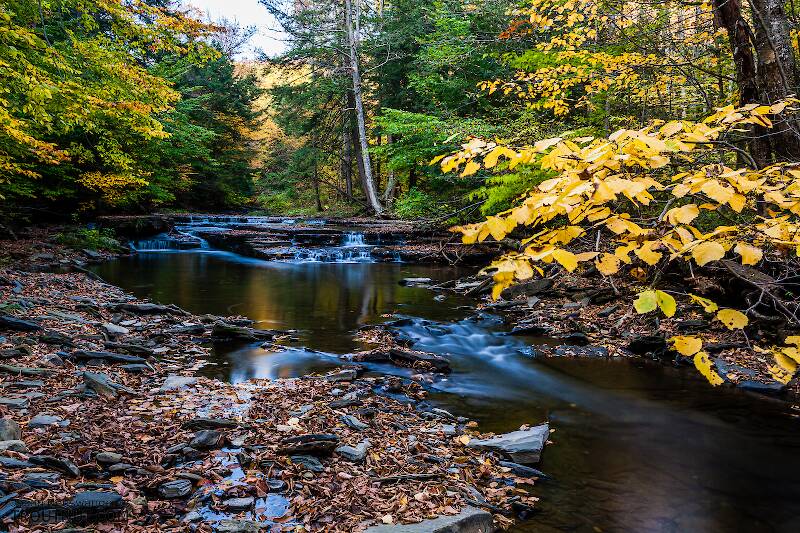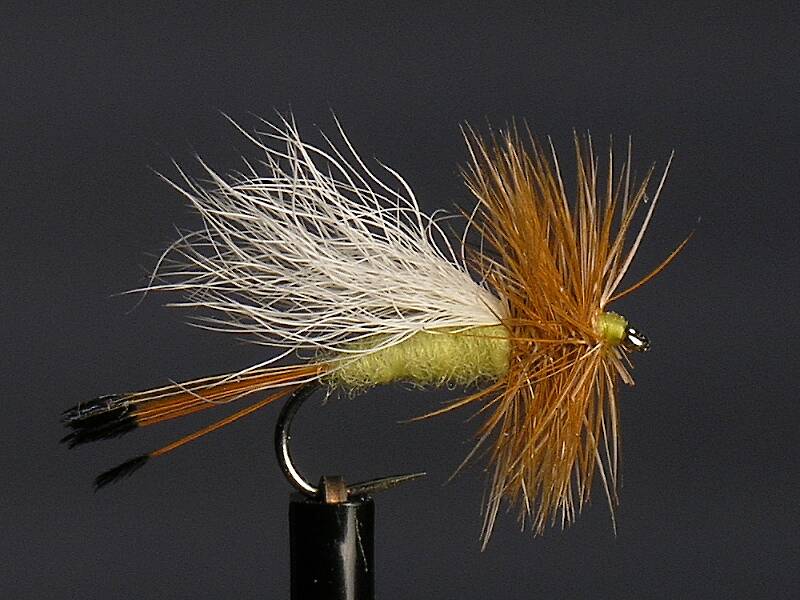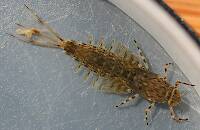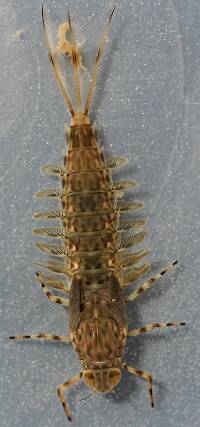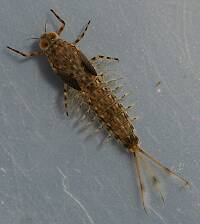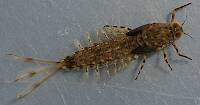
Salmonflies
Pteronarcys californica
The giant Salmonflies of the Western mountains are legendary for their proclivity to elicit consistent dry-fly action and ferocious strikes.
Featured on the forum
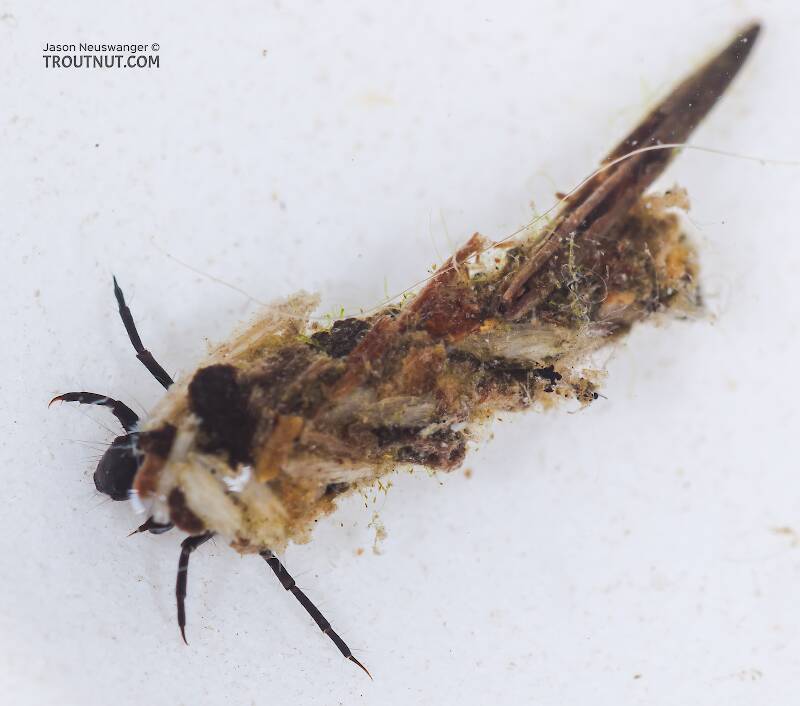
This seems to be a young larva of Limnephilus. Although not clear in the picture, several ventral abdominal segments have chloride epithelia.

Troutnut is a project started in 2003 by salmonid ecologist Jason "Troutnut" Neuswanger to help anglers and
fly tyers unabashedly embrace the entomological side of the sport. Learn more about Troutnut or
support the project for an enhanced experience here.
Demtrout
Posts: 6
Posts: 6
Demtrout on Aug 1, 2016August 1st, 2016, 9:02 pm EDT
Struggling to find workable patterns and techniques for some (SOME) emergences of the Little Yellow Stones.
Meanwhile I have yet to find the shucks of these common Isoperla on the rivers where I find the biggest emergences.
Am I looking in the wrong places --or is this genus an open water emerger rather than clambering out on the bank like so many other Plecoptera?
I have searched through a fair number of research papers and thesises (sp? plural of thesis lol) and have yet to find much in the way of discussion or research on the actual emergence of this particular group.
Any ideas on where to look for research or answers?
Meanwhile I have yet to find the shucks of these common Isoperla on the rivers where I find the biggest emergences.
Am I looking in the wrong places --or is this genus an open water emerger rather than clambering out on the bank like so many other Plecoptera?
I have searched through a fair number of research papers and thesises (sp? plural of thesis lol) and have yet to find much in the way of discussion or research on the actual emergence of this particular group.
Any ideas on where to look for research or answers?
Millcreek on Aug 2, 2016August 2nd, 2016, 8:32 am EDT
Try a google search using "Isoperla exuviae" (without the quotation marks). I found several references using it. All suggest that shucks can be found on streamside vegetation, stones on the side or in the middle of water and bridge abutments. I've found them on rocks on the side or on rocks in the middle of streams.
"If we knew what it was we were doing, it would not be called research, would it?"
-Albert Einstein
-Albert Einstein
PaulRoberts on Aug 5, 2016August 5th, 2016, 3:47 am EDT
I believe at least some do emerge mid-stream. They are enormously plentiful in my small mountain waters and there are not such numbers of exuviae streamside. Oddly, I also find few in trout stomachs. They are represented but not in teh number I would expect. They may be difficult to catch, or I wondered if some taste bad. Others elsewhere report trout eating them. Maybe I've just overlooked it here. Easy to do.
Bnorikane on Aug 13, 2016August 13th, 2016, 7:08 am EDT
I've not had much success with small yellow stonefly dry patterns, even when I see a lot of them flying around the stream. In high mountain streams, I often see them flying up from the water in fair numbers. They could be in stream emergers, returning for a drink or egg layers. If they were drinking or egg laying, I would expect to see them flying down to the stream in equal numbers, but I don't.
I haven't found any exoskeletons where I find larger golden stone exos. I speculate that these stoneflies may crawl up the bank and into the interior of bushes or other protected spots. Perhaps they emerge during the day and need better protection from birds while emerging. This is pure speculation on my part.
I haven't found any exoskeletons where I find larger golden stone exos. I speculate that these stoneflies may crawl up the bank and into the interior of bushes or other protected spots. Perhaps they emerge during the day and need better protection from birds while emerging. This is pure speculation on my part.
TimCat on Aug 15, 2016August 15th, 2016, 8:14 pm EDT
As implied above, I think they usually crawl out. Every stonefly shuck I've found has been pretty close to the water. On the bank, on rock, or on a fallen log hanging over or around the stream, but I'm in Michigan and we are most likely talking about two different species of little yellow stones.
Paul- I was wondering if they may taste bad myself. In June, I was fishing a river with a lot of golden stone nymphs floating and crawling in the stream. I couldn't catch a single fish under my indicator with a pretty good imitation of it that I bought at a local fly shop. Maybe my presentation was off (probably the case), but I thought I was getting good drifts in good water at the right depth. Now that I think about it, could the yellow be an evolutionary trait like the bumble bee or other brightly colored poisonous/bad-tasting animals? Maybe it is telling the fish "don't eat me, I taste bad"? These yellow stones in Michigan were pretty bright. Just a thought, and perhaps an uneducated one at that, Ha.
I've also read/heard people talk about how stoneflies are not nearly as important in the east as they are in the west, but you're in Colorado.
Paul- I was wondering if they may taste bad myself. In June, I was fishing a river with a lot of golden stone nymphs floating and crawling in the stream. I couldn't catch a single fish under my indicator with a pretty good imitation of it that I bought at a local fly shop. Maybe my presentation was off (probably the case), but I thought I was getting good drifts in good water at the right depth. Now that I think about it, could the yellow be an evolutionary trait like the bumble bee or other brightly colored poisonous/bad-tasting animals? Maybe it is telling the fish "don't eat me, I taste bad"? These yellow stones in Michigan were pretty bright. Just a thought, and perhaps an uneducated one at that, Ha.
I've also read/heard people talk about how stoneflies are not nearly as important in the east as they are in the west, but you're in Colorado.
"If I'm not going to catch anything, then I 'd rather not catch anything on flies" - Bob Lawless
Entoman on Aug 18, 2016August 18th, 2016, 1:49 pm EDT
The exuvia of these small stones are very delicate by comparison to their larger relatives so the difficulty in locating them (if they are terrestrial emergers) isn't surprising. However, I have observed these little guys appearing at the surface as if by magic just like mayflies. Out of curiosity, I have set myself up on a stream bank adjacent to runs where I could watch things up close and personal many times over the years. They do indeed show up at the surface from underneath. While many adults returned to the water, I never observed any diving under. To me, subsurface emergence is the most plausible explanation in many cases.
I believe insects are far more variable and adaptive in their behaviors than currently documented.
I believe insects are far more variable and adaptive in their behaviors than currently documented.
"It's not that I find fishing so important, it's just that I find all other endeavors of Man equally unimportant... And not nearly as much fun!" Robert Traver, Anatomy of a Fisherman
Afishinado on Aug 19, 2016August 19th, 2016, 2:33 am EDT
I've run into some sparse "hatches" of sallies (both yellow and lime) in some PA streams over the years. I believe they become more available to the trout during egg laying.
Here's a great article from Fly Fisherman mag to read on the subject, below. The article claims they have been known to hatch and be available in the drift in the evening and after dark.
http://www.flyfisherman.com/featured/little-yellow-stonefly/
Here's a great article from Fly Fisherman mag to read on the subject, below. The article claims they have been known to hatch and be available in the drift in the evening and after dark.
http://www.flyfisherman.com/featured/little-yellow-stonefly/
PaulRoberts on Aug 23, 2016August 23rd, 2016, 7:13 am EDT
Thanks for the article. Interesting that he bases his article on the Kettle Ck watershed. I'd fished that a bunch in the past and found a fluorescent yellow pattern to be esp effective there through the summer months -enough to make trout leave their lanes to intercept such flies. However the reasons, in my experience, turned out to be the abundance of bright green inchworms draped from the trees in those lush forests, and plopping into the stream.
Quick Reply
Related Discussions
Topic
Replies
Last Reply
2
Nov 4, 2012
by Aszat
by Aszat
1
Apr 12, 2007
by GONZO
by GONZO
Five days of warmwater flyfishing in southeastern Michigan - from Jonathon
In Fishing Reports by Jmd123
In Fishing Reports by Jmd123
0
Jul 22, 2009
by Jmd123
by Jmd123

